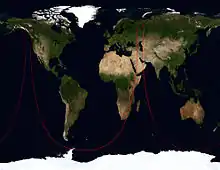| Mission type | Early warning |
|---|---|
| COSPAR ID | 2007-049A |
| SATCAT no. | 32268 |
| Mission duration | 4 years[1] |
| Spacecraft properties | |
| Spacecraft type | US-K[2] |
| Launch mass | 1,900 kilograms (4,200 lb)[3] |
| Start of mission | |
| Launch date | 23 October 2007, 04:39 UTC |
| Rocket | Molniya-M/2BL[2] |
| Launch site | Plesetsk Cosmodrome[2][3] |
| End of mission | |
| Deactivated | May 2012?[4] |
| Decay date | 5 January 2019, 07:58:00 UTC[5] |
| Orbital parameters | |
| Reference system | Geocentric |
| Regime | Molniya[2] |
| Perigee altitude | 519 kilometres (322 mi)[6] |
| Apogee altitude | 39,175 kilometres (24,342 mi)[6] |
| Inclination | 62.8 degrees[6] |
| Period | 704.44 minutes[6] |
Kosmos 2430 (Russian: Космос 2430 meaning Cosmos 2430) was a Russian US-K missile early warning satellite which was launched in 2007 as part of the Russian Space Forces' Oko programme.[7] The satellite was designed to identify missile launches using optical telescopes and infrared sensors.[2]
Kosmos 2430 was launched from Site 16/2 at Plesetsk Cosmodrome in Russia.[8] A Molniya-M carrier rocket with a 2BL upper stage was used to perform the launch, which took place at 04:39 UTC on 23 October 2007.[3] The launch successfully placed the satellite into a molniya orbit. It subsequently received its Kosmos designation, and the international designator 2007-049A.[3] The United States Space Command assigned it the Satellite Catalog Number 32268.[3]
In May 2012, it did not perform a manoeuvre and drifted off station.[4]
On 5 January 2019, it was caught on video[9] as it de-orbited over the North Island of New Zealand.[10]

See also
References
- ↑ Podvig, Pavel (2002). "History and the Current Status of the Russian Early-Warning System" (PDF). Science and Global Security. 10 (1): 21–60. Bibcode:2002S&GS...10...21P. CiteSeerX 10.1.1.692.6127. doi:10.1080/08929880212328. ISSN 0892-9882. S2CID 122901563. Archived from the original (PDF) on 2012-03-15.
- 1 2 3 4 5 "US-K (73D6)". Gunter's Space Page. 2012-03-08. Retrieved 2012-04-21.
- 1 2 3 4 5 "Cosmos 2430". National Space Science Data Centre. 2012-04-20. Retrieved 2012-04-25.
- 1 2 Pavel, Podvig (2012-11-13). "Changes in Russia's early warning satellite constellation". Russian Strategic Nuclear Forces. Retrieved 2012-11-28.
- ↑ "COSMOS 2430 - NORAD 32268". SatFlare. Retrieved 11 January 2019.
- 1 2 3 4 McDowell, Jonathan. "Satellite Catalog". Jonathan's Space Page. Retrieved 30 April 2012.
- ↑ Podvig, Pavel (October 23, 2007). "Launch of Cosmos-2430 early-warning satellite". Russian Strategic Nuclear Forces. Retrieved 18 May 2012.
- ↑ McDowell, Jonathan. "Launch Log". Jonathan's Space Page. Retrieved 2 May 2012.
- ↑ Jeff 🦄 (2019-01-05). "Sweet meteor shower over Gisborne just nowpic.twitter.com/IKifknbxIA". @peabnuts123. Retrieved 2019-01-05.
- ↑ "Cosmos 2430 (ID 32268) | The Aerospace Corporation". aerospace.org. 5 January 2019. Retrieved 2019-01-05.